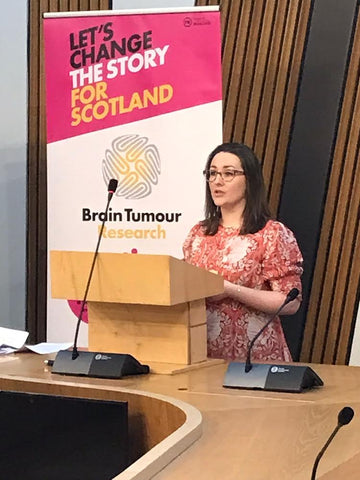Brain tumour patients and campaigners gathered today (Thursday 14th March) at the Scottish parliament to demand more investment to help find a cure and improve treatments.
More than 50 patients from across Scotland met with MSPs, including First Minister Humza Yousaf (pictured below with brain tumour patient Suzanne Davies), Scottish Health Secretary Neil Gray, and the Minister for Public Health and Women's Health Jenni Minto, at Holyrood to voice their concerns.

Our Patron, Theo Burrell, was among the attendees, after being diagnosed with an incurable glioblastoma (GBM) in June 2022. The Antiques Roadshow expert from Edinburgh underwent life-extending surgery, followed by radiotherapy and chemotherapy. Her most recent scan, on 8th January 2024, was stable.
Addressing the Scottish parliament, Theo said: "I'm not going to grow old and I'm very unlikely to see my son become a teenager."

More than 1,000 people in Scotland are diagnosed with a brain tumour every year, and around 400 people in the country die from high-grade brain tumours annually. The disease kills more children and adults under the age of 40 than any other cancer yet, just 1% of the national spend on cancer research has been allocated to this devastating disease.
Mum-of-one Theo, who suffered debilitating symptoms for six months before getting a diagnosis, said: “To be discussing brain tumours at the highest level of Government is so significant, and we are determined more is done by those in Holyrood to improve the way brain tumour patients are treated in Scotland.”
Among the speakers at our event, which took place during Brain Tumour Awareness Month, were Professor Steven Pollard from the University of Edinburgh and Dr Joanna Birch from the University of Glasgow.
Hugh Adams, Head of Stakeholder Relations at Brain Tumour Research, said: “There is amazing research coming out of Scotland from Professor Pollard and Dr Birch and their colleagues. There is a very simple equation here. If you put more money into research, you will get closer to cures and improving options.”
You can help to further life-saving research and bring hope to families affected by this devastating disease by making a donation, however big or small. Together, we will find a cure.
Related reading:

